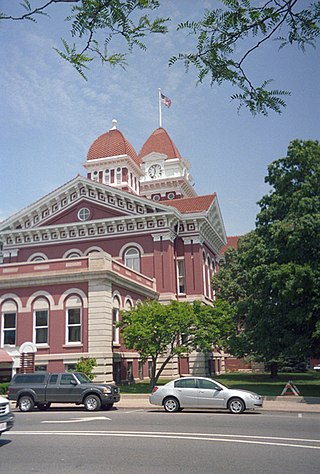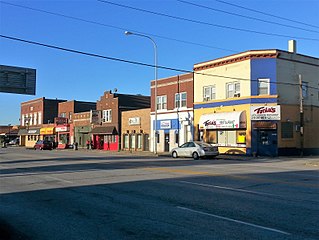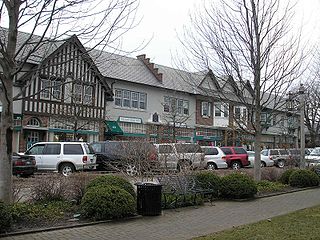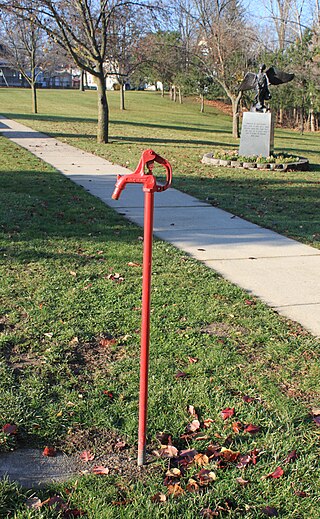
George Mortimer Pullman was an American engineer and industrialist. He designed and manufactured the Pullman sleeping car and founded a company town in Chicago for the workers who manufactured it. This ultimately led to the Pullman Strike due to the high rent prices charged for company housing and low wages paid by the Pullman Company. His Pullman Company also hired African-American men to staff the Pullman cars, known as Pullman porters, who provided elite service and were compensated only in tips.

Lake County is a county located in the U.S. state of Indiana. In 2020, its population was 498,700, making it Indiana's second-most populous county. The county seat is Crown Point. The county is part of Northwest Indiana and the Chicago metropolitan area, and contains a mix of urban, suburban and rural areas. It is bordered on the north by Lake Michigan and contains a portion of the Indiana Dunes. It includes Marktown, Clayton Mark's planned worker community in East Chicago.

East Chicago is a city in Lake County, Indiana, United States. The population was 29,698 at the 2010 census. The city is home of the Indiana Harbor and Ship Canal, an artificial freshwater harbor characterized by industrial and manufacturing activity. Situated along Lake Michigan, East Chicago is about 18 miles from downtown Chicago, Illinois and is just west of Gary, Indiana.

Fredericksburg is an unincorporated community and census-designated place (CDP) in Bethel Township, Lebanon County, Pennsylvania, United States. The population was 1,784 at the 2020 census, up from 1,357 at the 2010 census and 987 at the 2000 census.

Jens Jensen was a Danish-American landscape architect.

The Indiana Harbor and Ship Canal is an artificial waterway on the southwest shore of Lake Michigan, in East Chicago, Indiana, which connects the Grand Calumet River to Lake Michigan. It consists of two branch canals, the 1.25 miles (2.01 km) Lake George Branch and the 2 miles (3.2 km) long Grand Calumet River Branch which join to form the main Indiana Harbor Canal.
Northwest Indiana, nicknamed The Region after the Calumet Region, comprises Lake, Porter, LaPorte, and Newton counties in Indiana. This region neighbors Lake Michigan and is part of the Chicago metropolitan area. According to the 2020 Census, Northwest Indiana has a population of 831,080 and is the state's second largest urban area after the Indianapolis Metropolitan Area. It is also the home of the Indiana Dunes, parts of which have been preserved through conservation efforts. The town of Ogden Dunes houses the Hour Glass, a museum showcasing the ecological and conservation efforts of O. D. Frank.
The Civic Federation is a Chicago-based non-partisan research organization focused on governments in the Chicago area and the state of Illinois. The Civic Federation's mission is to help local and state governments reduce their costs and improve public services by "Promoting opportunities to reform local tax structures; guarding against wasteful expenditure of public funds; and serving as a technical resource to public officials and opinion leaders through non-partisan tax and fiscal research." The Federation was founded to fight corruption, government subsidies, high taxes, and unneeded public enterprise. However it also wanted government to solve the problems of the metropolis. The newspapers adopted Mugwumpery as a way of building support for municipal reform among working-class voters in the late 19th century and the Progressive Era.

The Youngstown Sheet and Tube Company, based in Youngstown, Ohio, was an American steel manufacturer. Officially, the company was created on November 23, 1900, when Articles of Incorporation of the Youngstown Iron Sheet and Tube Company were filed with the Ohio Secretary of State at Columbus. In 1905 the word "Iron" was dropped from the company name to reflect the company's shift in focus from producing wrought iron products to basic steel products. It acquired the Mark Manufacturing Company in 1923. Youngstown Sheet and Tube remained in business until 1977. A Youngstown resident acquired the name, trademark, and logo in 2014 and opened a small business promoting the economic redevelopment of Youngstown.
Roscoe Harold Zook was an American architect best known for his work in suburban Chicago, Illinois. He received a degree in architecture from the Armour Institute of Technology in 1914. In 1916 Zook married his first wife, Mildred Barnard. They divorced in the late 1930s. They had one son, Harold Barnard Zook, who followed in his father's footsteps to become an architect in Corona del Mar, California. In the early 1940s, Zook married his second wife, Florence (Barkey) Nissen, whom he met through mutual friends. Zook died in April 1949, just short of his 60th birthday.

Howard Van Doren Shaw AIA was an architect in Chicago, Illinois. Shaw was a leader in the American Craftsman movement, best exemplified in his 1900 remodel of Second Presbyterian Church in Chicago. He designed Marktown, Clayton Mark's planned worker community in Northwest Indiana.

Lockefield Gardens was the first public housing built in Indianapolis. Constructed during the years 1935 to 1938, it was built exclusively for low income African-Americans in Indianapolis. The complex was closed in 1976, and a number of structures were demolished in the early 1980s. The only original structures remaining are those along Blake Street.
The Bates–Hendricks neighborhood is situated just south and east of the downtown commercial district of Indianapolis, Indiana. The Fountain Square business district is just to the east.

Prairie Avenue is a north–south street on the South Side of Chicago, which historically extended from 16th Street in the Near South Side to the city's southern limits and beyond. The street has a rich history from its origins as a major trail for horseback riders and carriages. During the last three decades of the 19th century, a six-block section of the street served as the residence of many of Chicago's elite families and an additional four-block section was also known for grand homes. The upper six-block section includes part of the historic Prairie Avenue District, which was declared a Chicago Landmark and added to the National Register of Historic Places.

Clayton Mark and Company was a manufacturer of steel pipe and water well supplies located in Evanston, Illinois.
Clayton Mark, one of the pioneer makers of steel pipe in the United States, was an industrialist in the Chicago area who founded the Mark Manufacturing Company in 1888, a firm for the fabrication and sale of water-well supplies and Clayton Mark and Company in 1900. In addition, Mark founded Marktown, a planned worker community in Northwest Indiana on the National Register of Historic Places. He was known for his philanthropy and civic contributions.
Cyrus Mark was a prominent early advocate of nature conservancy in the state of Illinois. Mark served as the first Executive Director of the Illinois chapter of The Nature Conservancy. He was instrumental in the first Nature Conservancy acquisition in the Chicago area; Volo Bog. In 1958, Mark, along with George Fell, the first president of the Nature Conservancy, negotiated the purchase of Volo Bog by The Nature Conservancy.

Morse Dell Plain House and Garden, also known as Woodmar, is a historic home located at 7109 Knickerbocker Parkway in Hammond, Lake County, Indiana. The house was designed by noted Chicago architect Howard Van Doren Shaw and built in 1923. It is a large two-story, Tudor Revival style brick dwelling with a 1+1⁄2-story service wing. The landscape was designed by Jens Jensen in 1926.
North Harbor is a neighborhood in northeastern East Chicago, Indiana. It constitutes the portion of the Indiana Harbor section north of 138th Street. The neighborhood is home to one of the highest concentrations of affordable housing in the United States.




















